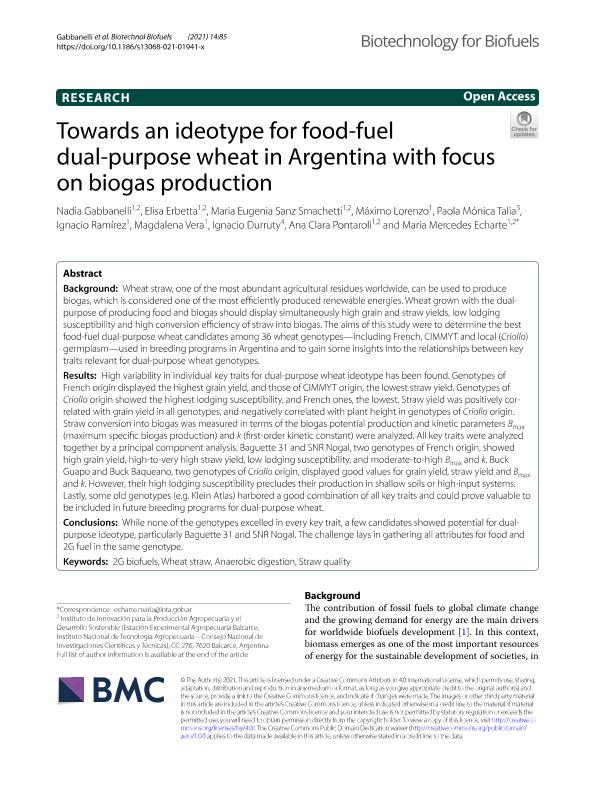Artículo
Towards an ideotype for food-fuel dual-purpose wheat in Argentina with focus on biogas production
Gabbanelli, Nadia ; Erbetta, Elisa
; Erbetta, Elisa ; Sanz Smachetti, María Eugenia
; Sanz Smachetti, María Eugenia ; Lorenzo, Maximo
; Lorenzo, Maximo ; Talia, Paola Monica
; Talia, Paola Monica ; Ramírez, Ignacio; Vera, Magdalena; Durruty, Ignacio
; Ramírez, Ignacio; Vera, Magdalena; Durruty, Ignacio ; Pontaroli, Ana
; Pontaroli, Ana ; Echarte, Maria Mercedes
; Echarte, Maria Mercedes
 ; Erbetta, Elisa
; Erbetta, Elisa ; Sanz Smachetti, María Eugenia
; Sanz Smachetti, María Eugenia ; Lorenzo, Maximo
; Lorenzo, Maximo ; Talia, Paola Monica
; Talia, Paola Monica ; Ramírez, Ignacio; Vera, Magdalena; Durruty, Ignacio
; Ramírez, Ignacio; Vera, Magdalena; Durruty, Ignacio ; Pontaroli, Ana
; Pontaroli, Ana ; Echarte, Maria Mercedes
; Echarte, Maria Mercedes
Fecha de publicación:
04/2021
Editorial:
BioMed Central
Revista:
Biotechnology For Biofuels
ISSN:
1754-6834
Idioma:
Inglés
Tipo de recurso:
Artículo publicado
Clasificación temática:
Resumen
Background: Wheat straw, one of the most abundant agricultural residues worldwide, can be used to produce biogas, which is considered one of the most efficiently produced renewable energies. Wheat grown with the dual-purpose of producing food and biogas should display simultaneously high grain and straw yields, low lodging susceptibility and high conversion efficiency of straw into biogas. The aims of this study were to determine the best food-fuel dual-purpose wheat candidates among 36 wheat genotypes—including French, CIMMYT and local (Criollo) germplasm—used in breeding programs in Argentina and to gain some insights into the relationships between key traits relevant for dual-purpose wheat genotypes. Results: High variability in individual key traits for dual-purpose wheat ideotype has been found. Genotypes of French origin displayed the highest grain yield, and those of CIMMYT origin, the lowest straw yield. Genotypes of Criollo origin showed the highest lodging susceptibility, and French ones, the lowest. Straw yield was positively correlated with grain yield in all genotypes, and negatively correlated with plant height in genotypes of Criollo origin. Straw conversion into biogas was measured in terms of the biogas potential production and kinetic parameters Bmax (maximum specific biogas production) and k (first-order kinetic constant) were analyzed. All key traits were analyzed together by a principal component analysis. Baguette 31 and SNR Nogal, two genotypes of French origin, showed high grain yield, high-to-very high straw yield, low lodging susceptibility, and moderate-to-high Bmax and k. Buck Guapo and Buck Baqueano, two genotypes of Criollo origin, displayed good values for grain yield, straw yield and Bmax and k. However, their high lodging susceptibility precludes their production in shallow soils or high-input systems. Lastly, some old genotypes (e.g. Klein Atlas) harbored a good combination of all key traits and could prove valuable to be included in future breeding programs for dual-purpose wheat. Conclusions: While none of the genotypes excelled in every key trait, a few candidates showed potential for dual-purpose ideotype, particularly Baguette 31 and SNR Nogal. The challenge lays in gathering all attributes for food and 2G fuel in the same genotype.
Palabras clave:
2G BIOFUELS
,
ANAEROBIC DIGESTION
,
STRAW QUALITY
,
WHEAT STRAW
Archivos asociados
Licencia
Identificadores
Colecciones
Articulos (IABIMO)
Articulos de INSTITUTO DE AGROBIOTECNOLOGIA Y BIOLOGIA MOLECULAR
Articulos de INSTITUTO DE AGROBIOTECNOLOGIA Y BIOLOGIA MOLECULAR
Articulos (IPADS BALCARCE)
Articulos de INSTITUTO DE INNOVACIÓN PARA LA PRODUCCIÓN AGROPECUARIA Y EL DESARROLLO SOSTENIBLE
Articulos de INSTITUTO DE INNOVACIÓN PARA LA PRODUCCIÓN AGROPECUARIA Y EL DESARROLLO SOSTENIBLE
Citación
Gabbanelli, Nadia; Erbetta, Elisa; Sanz Smachetti, María Eugenia; Lorenzo, Maximo; Talia, Paola Monica; et al.; Towards an ideotype for food-fuel dual-purpose wheat in Argentina with focus on biogas production; BioMed Central; Biotechnology For Biofuels; 14; 1; 4-2021; 1-16
Compartir
Altmétricas



